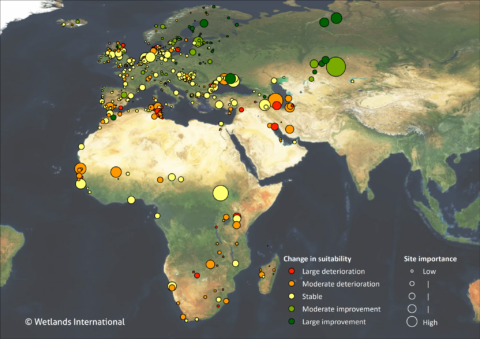Global S&T Development Trend Analysis Platform of Resources and Environment
| Conserving waterbird habitats to combat climate change impact for people and nature | |
| admin | |
| 2019-02-01 | |
| 发布年 | 2019 |
| 语种 | 英语 |
| 国家 | 国际 |
| 领域 | 地球科学 |
| 正文(英文) | 60% of Ramsar sites in Africa are likely to suffer from climate change. The Ramsar Convention on Wetlands of International Importance especially as Waterfowl Habitat aims to preserve waterbirds by helping to maintain networks of important bird habitat sites. Under the Climate Resilient Flyway (CRF) initiative Wetlands International, in partnership with governments, universities and other conservation NGOs, such as BirdLife International, works to support this aim. The initiative assesses the vulnerability of critical waterbird habitats along the African-Eurasian Flyway to the impacts of climate change and supports national and site level demonstration projects at the Inner Niger Delta, Mali and at Lake Abijatta, Ethiopia. Understanding the vulnerability of these ‘Critical Sites’ helps to ensure their preservation and resilience to climate change. To aid in this process, the CRF project has developed the Critical Sites Network Tool 2.0 (CSN), which uses Ramsar Criteria 2 and 6 to make predictions on the future suitability of wetlands for their qualifying waterbird species resulting from the impacts of climate change. “To make predictions, the CSN tool uses a range of waterbird species datasets, such as Important Bird and Biodiversity Areas as identified by BirdLife International, and the IUCN Red List, for which BirdLife is the global authority for birds,” said Dr. Ashton Berry, BirdLife’s Global Climate Change Programme Coordinator.  The map shows projected change in suitability for migratory waterbirds of Ramsar sites in the Africa-Eurasian Flyway by 2050. Funded by the International Climate Initiative on the basis of a decision adopted by the German Bundestag, the CSN promotes climate change adaptation planning by making information available on predicted changes in freshwater flow and inundation, the distribution of waterbird populations and the suitability of wetlands to form critical sites. The CSN tool is already proving its value by predicting that at least 30% of Ramsar Sites along the African-Eurasian flyway will be under threat by 2050. The situation is particularly alarming in Africa where almost 60% of the Ramsar Sites are likely to deteriorate, and only one site is likely to improve. Deterioration of these wetlands is linked to the significant range reductions of waterbird populations due to local and long-distance impacts of climate change. Many of the vulnerable sites are situated in arid and semi-arid regions where only small changes in rainfall can have a huge impact. “We can reduce the impact of climate change on waterbirds by introducing more sustainable management practices, such as reducing the amount of water extraction, reducing land degradation in the landscapes surrounding the wetlands and by conserving a comprehensive and coherent network of wetlands across the flyway” said Mr Merijn van Leeuwen, Overall Project Manager of the initiative. “In many cases, applying nature-based solutions that integrate the requirements of people and nature are a viable and the most cost-effective solution to maintain a functioning network of wetlands used by waterbirds along their flyway,” he said. Please contact Wetlands International ([email protected]) or BirdLife International ([email protected]) if you would like to discover more about these tools.
|
| URL | 查看原文 |
| 来源平台 | Wetlands International |
| 文献类型 | 新闻 |
| 条目标识符 | http://119.78.100.173/C666/handle/2XK7JSWQ/101833 |
| 专题 | 地球科学 |
| 推荐引用方式 GB/T 7714 | admin. Conserving waterbird habitats to combat climate change impact for people and nature. 2019. |
| 条目包含的文件 | 条目无相关文件。 | |||||
| 个性服务 |
| 推荐该条目 |
| 保存到收藏夹 |
| 查看访问统计 |
| 导出为Endnote文件 |
| 谷歌学术 |
| 谷歌学术中相似的文章 |
| [admin]的文章 |
| 百度学术 |
| 百度学术中相似的文章 |
| [admin]的文章 |
| 必应学术 |
| 必应学术中相似的文章 |
| [admin]的文章 |
| 相关权益政策 |
| 暂无数据 |
| 收藏/分享 |
除非特别说明,本系统中所有内容都受版权保护,并保留所有权利。
修改评论